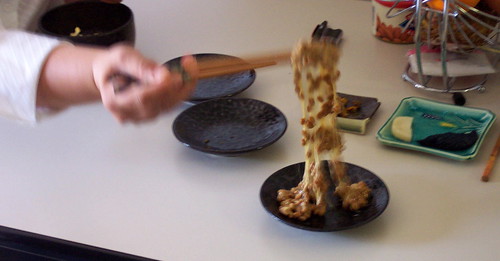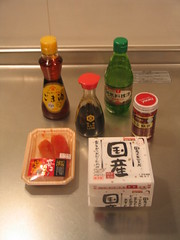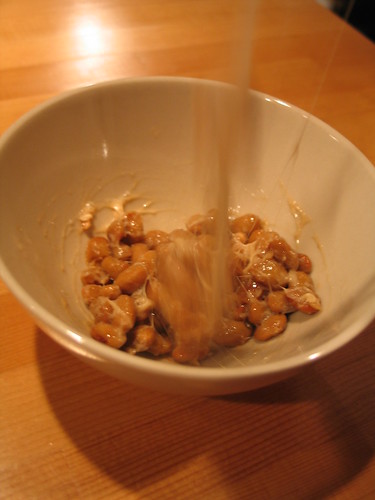Let’s talk about nattō (納豆), shall we?
Nattō is fermented soybeans, which you stir up with rice, mustard, and sliced negi scallions, as well as sometimes other things like raw egg, bits of raw fish, and so on. I don’t mind fermented soybeans in a number of their forms, but this stuff is nasty and has a truly unpleasant texture, since when you stir it vigorously it develops slimy strings that resemble what comes out of your nose when you have a very bad cold.
 In this photo (from “jasja dekker” photostream on Flickr, licensed under Creative Commons), you see that snotulosity that appears to be sauce? It’s not snot: that’s what nattō is like, because it’s essentially soybeans (the bean-looking things) that are fermenting to produce squidgy horror on the surface (the snot). Remember the movie Aliens, where all the aliens were covered with this gooey slime? Like that, only less carnivorous. I cannot imagine why both adults and children love to eat this stuff for breakfast. I mean, bad enough anyway, but seriously not something I want to face first thing in the morning, you know what I mean? Ugh.
In this photo (from “jasja dekker” photostream on Flickr, licensed under Creative Commons), you see that snotulosity that appears to be sauce? It’s not snot: that’s what nattō is like, because it’s essentially soybeans (the bean-looking things) that are fermenting to produce squidgy horror on the surface (the snot). Remember the movie Aliens, where all the aliens were covered with this gooey slime? Like that, only less carnivorous. I cannot imagine why both adults and children love to eat this stuff for breakfast. I mean, bad enough anyway, but seriously not something I want to face first thing in the morning, you know what I mean? Ugh. Now here, in a photo from the photostream “whalt,” you can see what happens when you stir the stuff up.
Now here, in a photo from the photostream “whalt,” you can see what happens when you stir the stuff up.Isn’t that delightful? Knew you would. If you are interested, search Flickr for "natto" and see what beautiful, horrible photos turn up (jasja dekker's photo is an especially lovely example).
The funny thing is, before I got here, I had an interesting experience with a Chinese-style hotpot dish I’d never had, in which the dipping sauce was made up of a whole bunch of weird things. Soy, sake (because we couldn’t find Shaoxing, the yellow rice wine), sesame oil, pungent shrimp paste, some kind of very spicy fish paste, and chunks of very-fermented tofu. You stir this up into a medium-thin paste and dunk your food in it. It was good, but I decided I didn’t really like the shrimp and fish things, so the next time around I did soy, sake, sesame oil, hot sesame oil, and the fermented tofu, and it was excellent. I ended up with jars of the makings, so I started putting this sauce together late at night as a snack. So my wife and I thought, “hey, if Chris likes this stuff, which is pretty pungent and basically nasty, he’ll probably like nattō.”
No such luck, it seems.

So… time for experiments. Maybe I just don’t like what the Japanese do with nattō, and think it could be done better some other way, right? Let’s try it: soy, sake, sesame oil, hot fermented bean paste (ladoubanjiang 辣豆瓣酱), and nattō, all whisked up together. We’ll try it with and without seafood pastes, for which in take two I’ll try karatarako (辛鱈子), which is semi-spicy salt-preserved pollock roe.
Here goes: my step by step in-process photos!
First, the fixin’s. Front and center, the nattō in its three-tiered supermarket package. Then, clockwise around, the karatarako, sesame oil, soy sauce, cooking sake (I’m not wasting good stuff on an experiment this dubious!), and doubanjiang.
Now let’s take a good look at that yummy nattō! Open up the package and take a little stir….

And...

Okay now that our appetites are whetted, let me point out that nattō has a distinctive smell, not one that a whole lot of people outside Japan find attractive. Some say it smells a bit like blue cheese, and there’s a bit of truth in that, I suppose. Mostly I think it smells like itself, which I realize isn’t the most helpful thing to say. It’s pungent, a bit cheesy-musty, a little like overnight-soaked beans, and at the same time just a little bit nutty. If you can imagine that, I’ll bet you’ve had nattō already, because it’s not much of a description.
Now in this photo, I have added a medium dash of soy, a small dash of cooking sake, a splash of sesame oil, and about 1 Tb of doubanjiang, and then stirred vigorously. Looks unpleasant, doesn’t it? See those nice bubbles of gross sliminess, now special Chinese-style spicy gross sliminess?

Here’s some bar food to eat with this delicious dish: deep-fried vegetable dumplings, kara age (fried chicken chunks), salty edamame beans boiled in the shell.

So what’s the verdict?
Actually, it’s not bad at all. It’s kind of pungent, and my wife insisted that before I go to bed I have to eat the last bit, because she doesn’t want the house to smell like nattō when she gets up in the morning. But suddenly it is transformed from slimy pungent stuff that has almost no good qualities to something that has a few unfortunate qualities (slime!) but is really quite decent. You wouldn’t want to eat a whole lot of it at once, I think, but a little bit is fine. The sticky slimy stuff turns into something almost resembling sauce, and it’s pretty good when you dunk the fried dumplings or chicken into it. The whole beans retain their firmness, and the sesame oil enormously complements the subtle nuttiness of the nattō.
So my conclusion? A couple things first….
For one thing, you have to take into consideration the fact that I used very low-end ingredients at every level, in the sense that whereas the soy is sort of mid-low grade, the nattō, sake, sesame oil, and doubanjiang are all rock-bottom basics. If I went with the best I could get, everything would be much improved, I am sure.
You also have to recognize that I have not yet tried the kara tarako (spicy Pollock roe) in the mix, and my current feeling is that there is something, some other pungent-rich flavor, that’s missing. My guess is that the roe will be perfect, although there are other things you could use (shrimp paste, uni, grilled eel liver, whatever), each of which would have its own powerful flavor to deepen and complicated the mixture. I will try this soon and keep you posted.
In the meantime, my conclusions?
Nattō isn’t half bad, and in fact can be quite decent in its way. The problem is that in my opinion, the Japanese don’t know what to do with it. They are under the impression that its worst qualities are its best, and they don’t understand that the pungent intensity of nattō requires other kinds of pungency to bring out its best qualities. As far as I’m concerned, nattō should be bar food: salty, pungent, spicy, and a bit rich, and served with cold beer. Eating it in the morning is bizarre.
I can see using mustard instead of doubanjiang, but I think the nutty fermented flavor of the latter helps develop the good side of the soybean flavor of the nattō. I like the sliced negi with the dish, and may try adding that when I also add the roe. I can see why you'd want to add the richness of egg, but I think it's slimy enough without raw egg, thanks very much, so I'll stick to sesame oil and perhaps the rich roe.
If you like nattō already, you are probably shocked by this conclusion. If you like nattō already, though, I can’t help you: it’s too late. If you don’t like it, you would possibly be pleasantly surprised by my concoction, and if you are ever under the gun to eat a big serving of the stuff I hope you will remember these principles. If you’ve never had it, I strongly recommend that you skip it.




2 comments:
Try Fujikko's Kuromame Natto (フッ子 黒豆納豆), it is different and not very stinky. It is available at most supermarkets.
From my experience, the bigger the beans and the higher the price, the better natto tastes.
But, natto is not for everybody.
Okay, I'll try it.
But I'm not exactly leaping out of my seat with anticipation....
Post a Comment